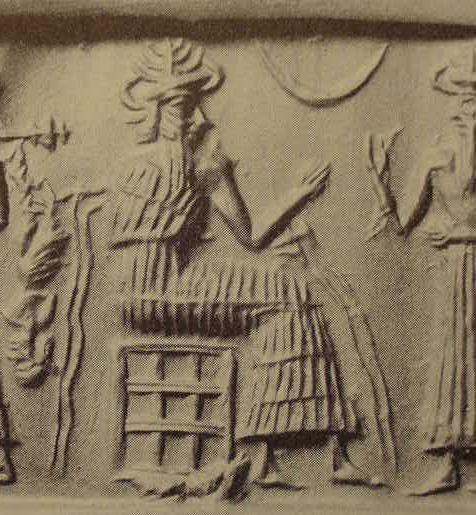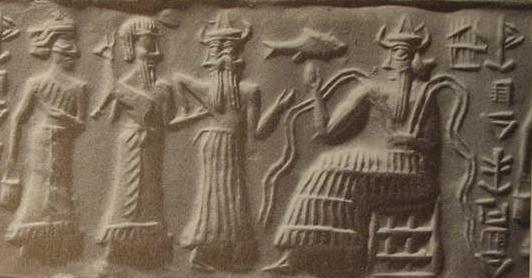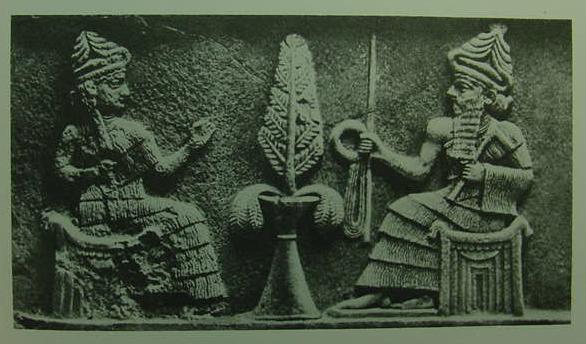Images of the Sumerian god Enki of Eridug
also known as the Akkadian (Babylonian) Ea of Eridu
22 July 2008
Below are photos or pictures of cylinder seal impressions in clay showing the god known as Enki to the Sumerians and Ea to the Akkadians (Babylonians).
Enki/Ea is usually distinguished from other gods by two streams of water erupting from his body, sometimes the water erupts from a pot held in his hands. It is possible that other gods were portrayed holding a pot with two streams of water erupting from it, but water erupting from a god's body apparently is limited to Enki/Ea.
Enki/Ea is further distinguished from other gods by his two-faced vizier Isimud who serves him in texts.
My interest in Enki/Ea is that I understand he is one of several gods who came to be later fused together and transformed by the Hebrews into Yahweh-Elohim as well as the Serpent in the Garden of Eden in the Book of Genesis (Please click here for further information). Other Mesopotamian gods assimilated to Yahweh are Enlil of Nibru (Akkadian: Ellil of Nippur), An of Unuk (Akkadian Anu of Uruk), Utu the sun-god (Akkadian Shamash). The below "identifications" with various gods are my own.
Below, Enki/Ea seated. His two-faced vizier Isimud accompanied by two gods. One bears a tree branch the other a bird-man, apparently trophies captured after some effort? (cf. fig. II-23. Edith Porada, editor.
Ancient Art in Seals, Essays by Pierre Amiet, Nimet Ozuc & John Boardman. Princeton, New Jersey. Princeton University Press. 1980)
Enki/Ea seated, holding a pot with two streams, fish leaping from streams. A god with horned helmet brings a captured bird-man with bound hands followed by a god with a mace (?) as a guard (?). A worshipper with animal observes the scene. (cf. fig. I-8. Edith Porada, editor. Ancient Art in Seals, Essays by Pierre Amiet, Nimet Ozuc & John Boardman. Princeton, New Jersey. Princeton University Press. 1980)
Enki/Ea seated with two streams erupting from pot (?) held against his belly. Fish leaping from stream. Two-faced vizier Isimud presents a human with an animal offering. A woman holding a bucket (?) accompanies the offerer.
(fig. 472. p. 184. Briggs Buchanan & Wiliam W. Hallo. [Ulla Kasten, Editor.] Early Near Eastern Seals in the Yale Babylonian Collection. New Haven & London. Yale University Press. 1981)
Below, a bronze figurine showing a four-faced god with helmet or cap surmounted by bull's horns with one foot on a recumbant ram. The dress is similar to that worn by Enki on the above cylinder seals (cf. p. 229. Barthel Hrouda, et al. Der Alte Orient Geschichte und Kultur des alten Vorderasien. Munchen, Deutschland. C. Bertelsmann Verlag GmbH. 1991)
Below two gods, Ningishzida (with serpent-dragon heads erupting from shoulders) and possibly Dumuzi (?) with a staff, present the king of Lagash, Gudaea (ca. 2275-2260 B.C.) to perhaps Enki? The gods' garments are similar to those worn by Enki/Ea in the above cylinder seals. The gods' helmets consist of four rows of bull's horns which identify them as being deities. Enki on some of the above seals also wears a similar crown made up of rows of bull's horns ( for photo cf. p. 63. John Gray. Near Eastern Mythology. London. Hamlyn Publishing Group, Limited. 1969)
The above pictures, seals and bas-reliefs and figurines, are to bring together "a composite" to enable the reader or viewer to imagine how Enki/Ea was probably envisioned by the ancient Mesopotamians in the 3rd-2nd millenniums B.C. Cylinder seals by their nature are very small and the artist is restricted by this small and difficult medium (stone) as to what can be artistically rendered with an engraving tool. The above larger formats, bas-relief and figurine, allow for more detail and a more "proper rendering" of what a god looked like.
In the Mesopotamian myths Enki/Ea shares several motifs with Yahweh-Elohim:
(1) Both are credited with man's creation.
(2) Both place man in their garden to care for it.
(3) Both have a garden in a location called Eden in Hebrew and Edin in Sumerian.
(4) Both allow man to acquire forbidden knowledge but deny him immortality.
(5) Both warn one man to build a boat and put aboard it the seed of man and animals for a new post-flood beginning.
(6) Both turn the one language of the world into a confusing babel of many tongues.
(7) Both rested on a 7th Day after the creation of mankind. Please click here for the story.
Below a seated goddess and god wearing garments similar to those worn by Enki/Ea in the above cylinder seals.
The below god has a helmet with 4 rows of bull's horns, he holds an axe in one hand and a rod and ring in the other, symbols of rule. Between them is perhaps a date palm seedling with date clusters hanging over the edge of the urn (For the below picture cf. p. 9. Diana Wolkstein & Samuel Noah Kramer. Inanna Queen of Heaven and Earth, Her Stories and Hymns From Sumer. New York. Harper & Row. 1983). Note: This bas-relief was found at Ur and some scholars suggest this is the god Nanna or Nannar (Sin) and his wife Ningal.







